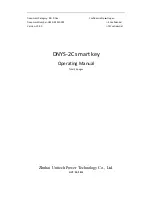
Instruction and Operating Manual
Overspeed Protector CTO-B45202
2019 / 02
J.M. Voith SE & Co. KG │ Division Digital Ventures
Page: 5 / 25
918 3626018864 en
D – 74564 Crailsheim
Version: 2.1
Electrical Data
Supply voltage (power) including residual ripple
24 (+10% / -15%)
5)
V DC
Current consumption
0.5 A±0.2A, max. 3 A for t < 1.5±0.5 sec
Trip-stop frequency f
ss
4000…10000Hz adjustable in 256 steps,
accuracy 0.25%
6)
, nameplate, temperature error
120ppm/K
Actual speed remote indication
4…20mA, for f=0… f
ss
Speed input
Connect an inductive speed sensor, preferably
sinusoidal voltage, permissible voltage range
0.5Vrms...18Vrms (when connected), permissible
internal resistance range 600Ω…4500Ω
7)
Other data
Function - Trip Simulation (partial stroke
check)
Disconnecting time with Potentiometer T4
10ms…25ms
Trip time of overspeed shutdown
40ms at T
oil
<40°C
8)
Trip criteria
See Chapter 3.4
5) Permanent operation of CTO is allowed within this supply voltage range
6) The indication refers to the trip frequency re-measured after the adjustment, as shown on the nameplate.
7) Thei DC voltage resulting depends on the internal resistance of the speed se
nsor. For an internal resistance of 1000 Ω,
the DC offset voltage is 1.65V
±
0.15V.
8) The tripping time is the time required by the control piston to move to its completely open position (end stop) after the
shutdown incident occurred, including a dead time of approx. 10ms. On account of the damping of the movement caused by
the pressure medium, the tripping time depends on the viscosity of the pressure medium. It can be determined by recording
the stroke of the trip-stop valve. When the trip-stop valve moves with constant speed after a trip-top initiation, them the
control piston of the CTO has reached its end position.
Содержание 91868550
Страница 26: ......






































